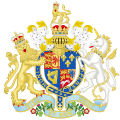| Governor of North Carolina | |
|---|---|
 | |
| Style | His Excellency |
| Residence | Governor's Palace, Newbern |
| Appointer | Monarch of Great Britain |
| Term length | At His Majesty's pleasure |
| Formation | January 24, 1712 |
| First holder | Edward Hyde |
| Final holder | Josiah Martin |
| Abolished | July 4, 1776 |
The governor of North Carolina from 1712 to 1776 was the representative of the British monarch in North Carolina. From 1729 to 1776, he was appointed by the monarch on the advice of the secretary of state for the Southern Department and the Board of Trade. The role of the governor was to act as the de facto head of state, and he was responsible for appointing members of the provincial government after a general election. The governor served as the commander in chief of the provincial militia and had sole responsibility for defence and security. [1] [2] [3] [4] [5]
Contents
Besides the governor, other provincial officials included a secretary, attorney general, surveyor general, the receiver general, chief justice, five customs collectors for each of the five ports in North Carolina, and a council. The council advised the governor and also served as the upper house of the legislature. The president of the council occasionally served as acting governor. [1]









